2024 Solar Eclipse Countdown
Overview
|
A solar eclipse happens when the Moon passes between the Sun and Earth at just the right moment. Sometimes, the Moon only blocks part of the Sun’s light which is called a partial solar eclipse. Other times, the Moon blocks all of the Sun’s light which is called a total solar eclipse. As the Moon blocks the Sun’s light, it casts a shadow on part of the Earth. The Moon’s shadow creates a trail as Earth rotates, and this trail is called the path of totality. Places in the path of totality will experience total darkness during an eclipse since the Moon completely blocks the Sun's light for a few minutes resembling night time. On Monday, April 8, 2024, a total solar eclipse will cross North America. The eclipse will pass over parts of Mexico, the central and eastern United States, and southeastern Canada. The path of totality will first enter the United States in Texas, then pass through Oklahoma, Arkansas, Missouri, Illinois, Kentucky, Indiana, Ohio, Pennsylvania, New York, Vermont, New Hampshire, and Maine. Cleveland, as well as much of northern Ohio and northwest Pennsylvania, will experience totality during the mid afternoon. Cleveland will experience totality between 3:13 and 3:17 PM EDT. |
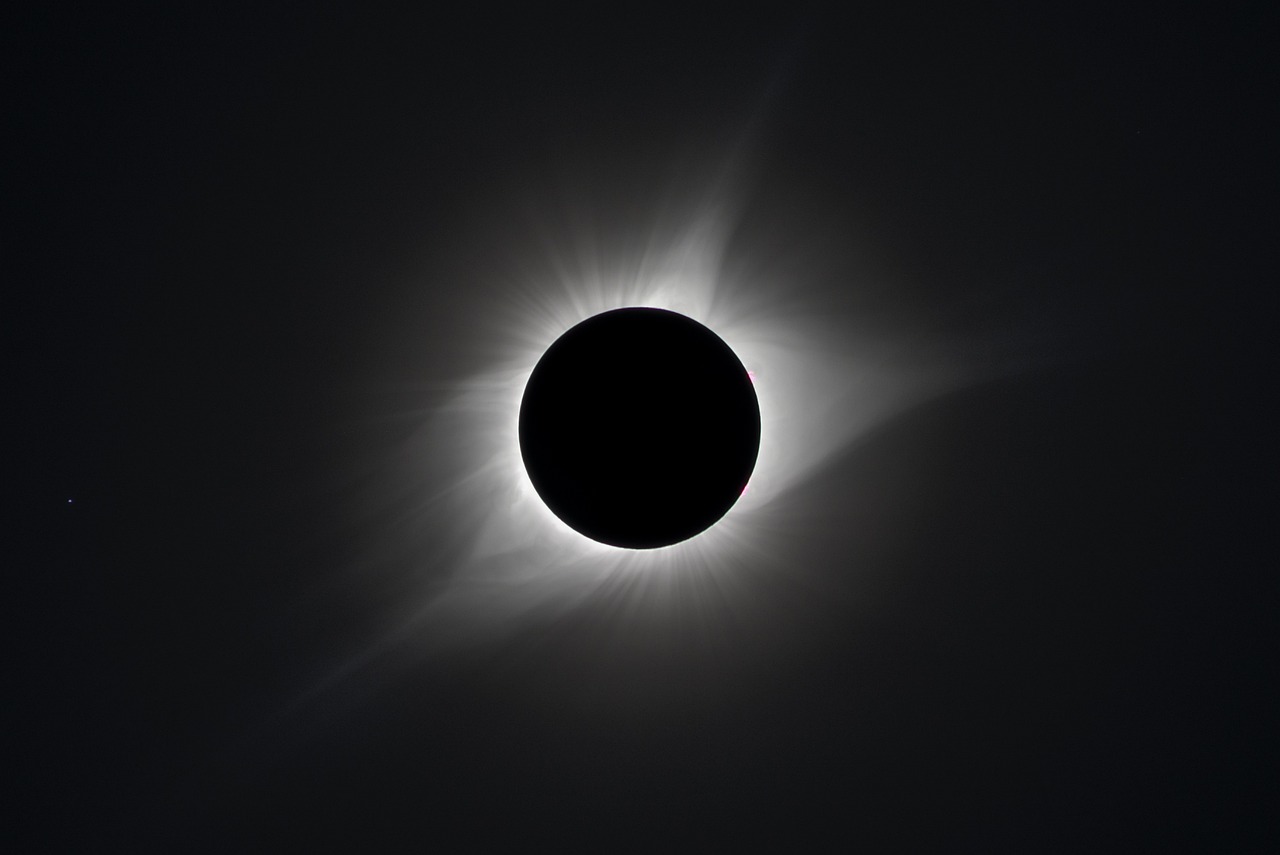 |
Time of Totality
Findlay, OH will experience totality between 3:10-3:14 PM EDT.
Cleveland, OH will experience totality between 3:13-3:17 PM EDT.
Erie, PA will experience totality between 3:16-3:20 PM EDT.
(For additional path of totality location and timing of the totality, please see the table and graphic below.)
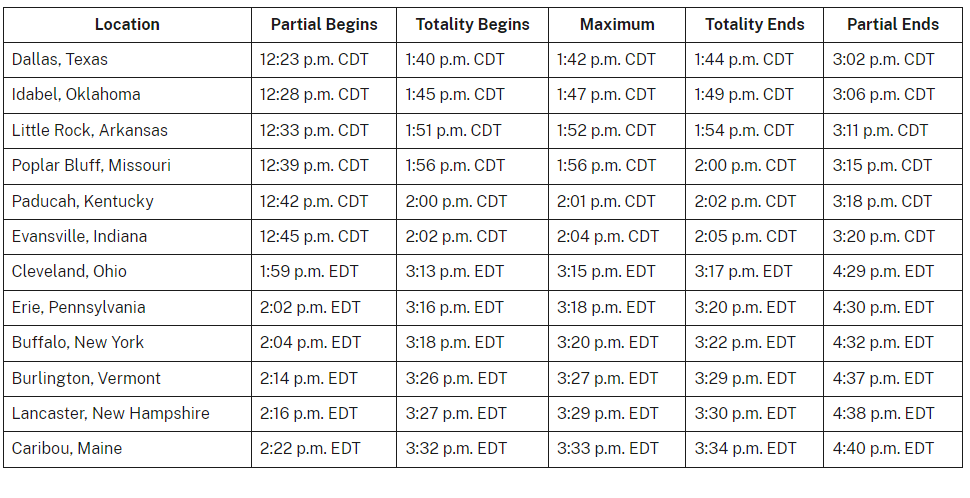
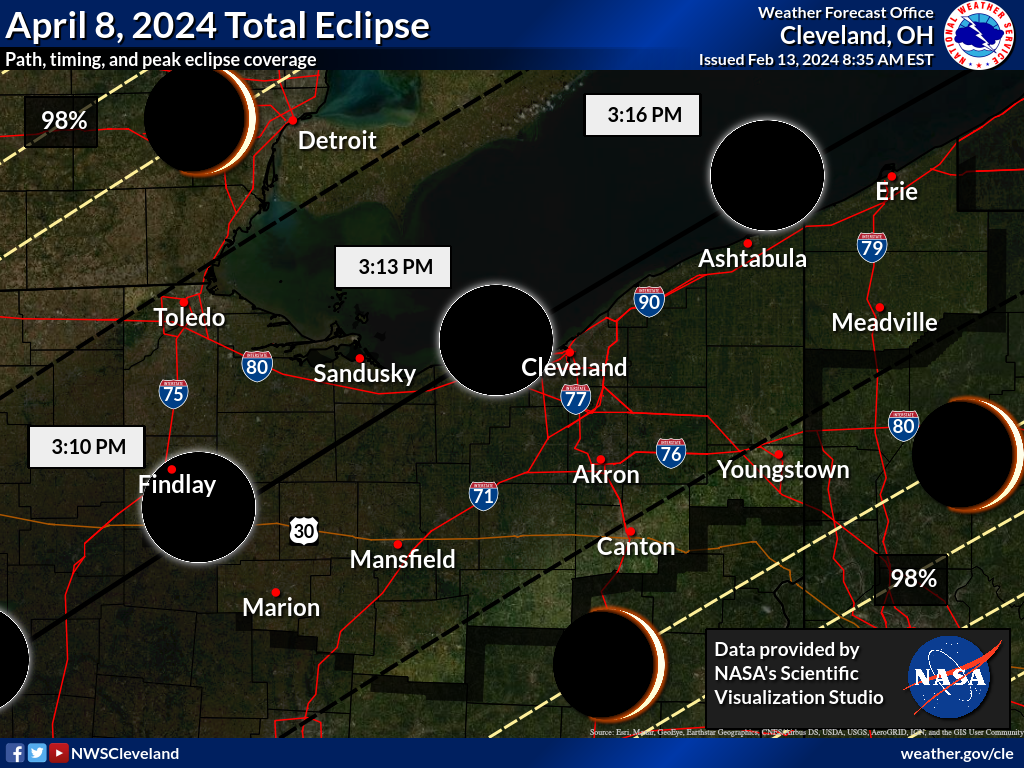
(Chart Credit: NASA)
NWS Cleveland Total Solar Eclipse Handout (includes times of totality and a FAQ)
Historical Climate
Local Climatology
Below is an extensive look at the weather conditions on April 8th. The climate information shown is for all cities with official observing equipment in the NWS Cleveland County Warning Area (CWA). Check out the information for an airport closest to you below!
|
Akron-Canton Regional Airport
|
Akron Fulton International Airport
|
Northeast Ohio Regional Airport
|
| Akron-Canton Regional Airport data is from 1949 to present. Check out additional climate information for CAK here. | Akron Fulton International Airport data is from 1887 to present. | Northeast Ohio Regional Airport data is from 1999 to present. |
|
Burke Lakefront Airport
|
Cleveland-Hopkins International Airport
|
Cuyahoga County Airport
|
| Burke Lakefront Airport data is from 1973 to present. | Cleveland-Hopkins International Airport data is from 1938 to present. Check out additional climate information for CLE here. | Cuyahoga County Airport data is from 1983 to present. |
|
Erie International Airport
|
Findlay Airport
|
Lorain County Regional Airport
|
| Erie International Airport data is from 1926 to present. Check out additional climate information for ERI here. | Findlay Airport data is from 1942 to present. | Lorain County Regional Airport data is from 1999 to present. |
|
Mansfield Lahm Regional Airport
|
Marion Municipal Airport
|
Port Meadville Airport
|
| Mansfield Lahm Regional Airport data is from 1948 to present. Check out additional climate information for MFD here. | Marion Municipal Airport data is from 1999 to present. | Port Meadville Airport data is from 1998 to present. |
|
Knox County Airport
|
Erie-Ottawa International Airport
|
Portage County Regional Airport
|
| Knox County Airport data is from 2008 to present. | Erie-Ottawa International Airport data is from 2017 to present. | Portage County Regional Airport data is from 2011 to present. |
|
Eugene F. Kranz Toledo Express Airport
|
Toledo Executive Airport
|
Lake County Executive Airport
|
| Eugene F. Kranz Toledo Express Airport data is from 1955 to present. Check out additional climate information for TOL here. | Toledo Executive Airport data is from 1939 to present. | Lake County Executive Airport data is from 2015 to present. |
|
Wayne County Airport
|
Youngstown-Warren Regional Airport
|
| Wayne County Airport data is from 1997 to present. | Youngstown-Warren Regional Airport data is from 1896 to present. Check out additional climate information for YNG here. |
​National Climate Information
For additional information, including weekly, monthly, and seasonal outlooks, please refer to the NWS Climate Prediction Center.
Cloud Cover
Below is the cloud cover climatology for the afternoon of April 8th for all years (left) and only El Nino years (right). The current climatological outlook suggests El Nino conditions will be present during the time of the 2024 Solar Eclipse. The primary area this will impact looks to be along the lakeshore where there is historically more cloud cover compared to years without an El Nino pattern.
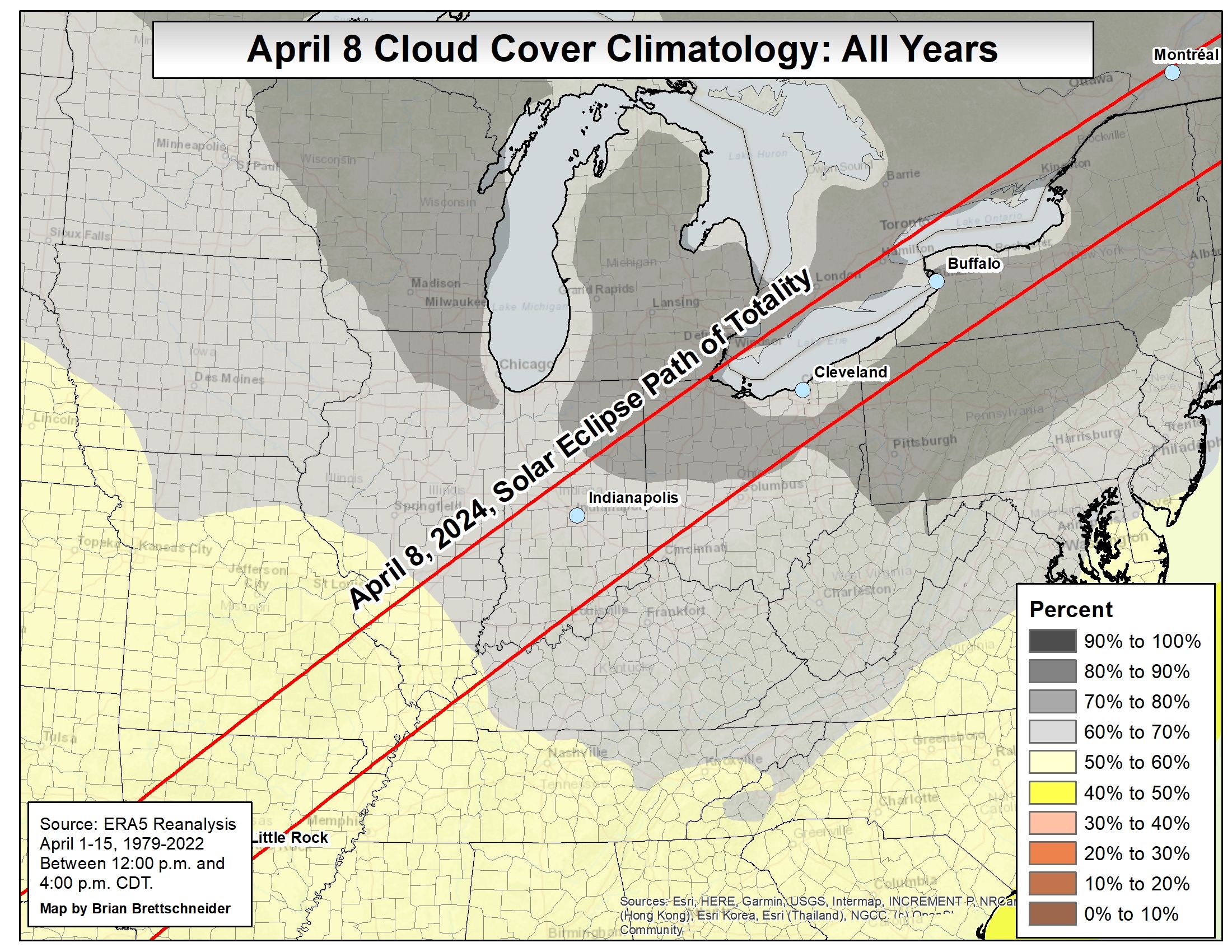
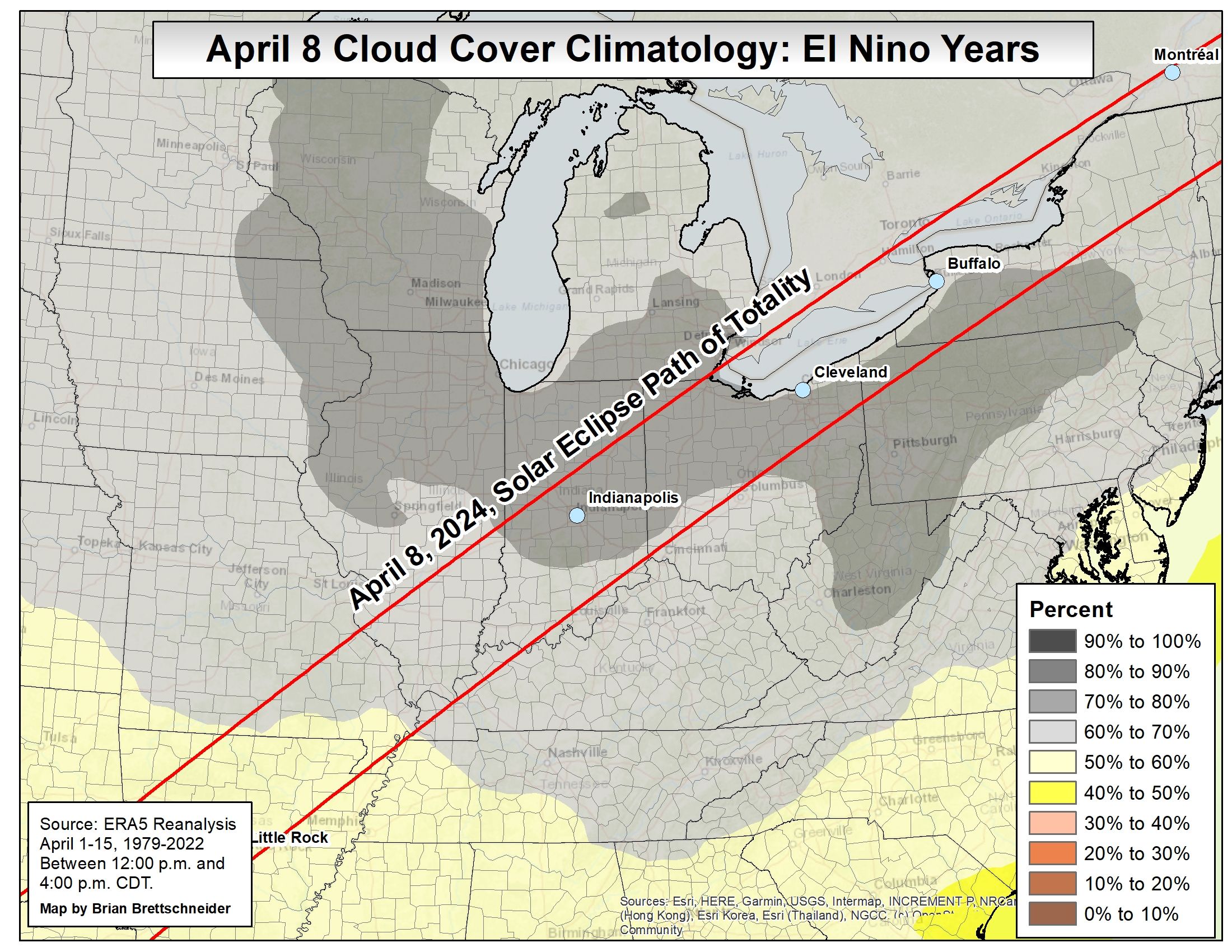
(Maps courtesy of Brian Brettschneider, NOAA)
The graphics below take a close look at the observed weather and sky coverage on April 8th. The climate information shown is for all cities with official observing equipment in the NWS Cleveland County Warning Area (CWA). The information from the sky coverage data was derived from raw observations during the 5 hour period surrounding the time of totality (1PM to 5PM LDT). If there were multiple sky coverage categories observed within this 5 hour time period, the worst sky coverage category (Clear, Few, Scattered, Broken, Overcast) was used to represent a given year. The caveat is that none of this data includes clouds above 12,000 feet, possibly making it seem less cloudy than it actually was. Check out the information for an airport closest to you below!
|
Akron-Canton Regional Airport
|
Akron Fulton International Airport
|
Northeast Ohio Regional Airport
|
| Akron-Canton Regional Airport data is from 1949 to present. Check out additional climate information for CAK here. | Akron Fulton International Airport data is from 2000 to present. | Northeast Ohio Regional Airport data is from 1999 to present. |
|
Burke Lakefront Airport
|
Cleveland-Hopkins International Airport
|
Cuyahoga County Airport
|
| Burke Lakefront Airport data is from 1973 to present. | Cleveland-Hopkins International Airport data is from 1948 to present. Check out additional climate information for CLE here. | Cuyahoga County Airport data is from 1993 to present. |
|
Erie International Airport
|
Findlay Airport
|
Lorain County Regional Airport
|
| Erie International Airport data is from 1948 to present. Check out additional climate information for ERI here. | Findlay Airport data is from 1973 to present. | Lorain County Regional Airport data is from 1999 to present. |
|
Mansfield Lahm Regional Airport
|
Marion Municipal Airport
|
Port Meadville Airport
|
| Mansfield Lahm Regional Airport data is from 1960 to present. Check out additional climate information for MFD here. | Marion Municipal Airport data is from 1999 to present. | Port Meadville Airport data is from 1998 to present. |
|
Knox County Airport
|
Erie-Ottawa International Airport
|
Portage County Regional Airport
|
| Knox County Airport data is from 2008 to present. | Erie-Ottawa International Airport data is from 2017 to present. | Portage County Regional Airport data is from 2012 to present. |
|
Eugene F. Kranz Toledo Express Airport
|
Toledo Executive Airport
|
Lake County Executive Airport
|
| Eugene F. Kranz Toledo Express Airport data is from 1955 to present. Check out additional climate information for TOL here. | Toledo Executive Airport data is from 1998 to present. | Lake County Executive Airport data is from 2015 to present. |
|
Wayne County Airport
|
Youngstown-Warren Regional Airport
|
| Wayne County Airport data is from 1997 to present. | Youngstown-Warren Regional Airport data is from 1948 to present. Check out additional climate information for YNG here. |
Current Weather
|
|
|
|
|
|
| Today's High Temp | Today's Low Temp |
|
|
|
Safety Information
|
(Photo Credit: NASA/Mamta Patel Nagaraja) Eye and Skin Safety for a Total Solar Eclipse Except during the brief totality of a total solar eclipse, when the Moon completely blocks the Sun’s bright face, it is not safe to look directly at the Sun without specialized eye protection for solar viewing. Looking at any part of the bright Sun through a camera lens, binoculars, or a telescope without a special-purpose solar filter secured over the front of the optics will instantly cause severe eye injury. Below are some important safety guidelines to follow during a total solar eclipse courtesy of NASA:
Cold Water Safety Water temperatures on Lake Erie in early April average in the upper 30's to low 40's F, so viewing the eclipse from a small boat will be dangerous. Water temperatures below 55°F can cause cold water shock, leading to death within one minute of falling into the cold water. Without a dry suit, survival of more than five minutes is unlikely due to hypothermia. The average death rate for boating accidents is 45% when the water temperature is colder than 50°F but only 11% when the water temperature is 70 to 79 F. Signs of cold water shock are gasping for breath, rapid breathing, sudden spike in heart rate and blood pressure, and cognitive impairment. Viewing the eclipse from a boat without a dry suit is not recommended. Below are the average Lake Erie water temperatures offshore of Cleveland each day of the year, as well as additional cold water dangers.
|
FAQs
What can people expect during the eclipse?
During the eclipse, the sky will get dark as if it were dawn or dusk. Even if skies are cloudy, people will still notice a darkening of the sky. Nocturnal wildlife may awaken while non-nocturnal wildlife may think it’s time for bed.
What safety precautions should be taken to view the eclipse?
When watching the partial phases of the solar eclipse, which happens before and after totality, you must look through safe solar viewing glasses (“eclipse glasses”) or a safe handheld solar viewer. It is not safe to look at the partially eclipsed sun through a camera lens, telescope, binoculars, sunglasses, or any other optical device even while wearing eclipse glasses, as the concentrated solar rays will burn through the filter and cause serious eye injury. Only during the brief total phase of a total solar eclipse, when the Moon completely blocks the Sun’s bright face, is it safe to view without specialized eye protection.
What effects might the eclipse have on the weather?
Research has shown that temperatures can drop between 4-10 degrees Fahrenheit during the eclipse. In addition, some reduction in wind speed and low-level clouds are possible.
How might Lake Erie impact the weather conditions on the day of the event?
Lake Erie could impact weather conditions on the day of the eclipse, but it has a lot to do with the weather pattern on the day of the event. On a warm spring day, sometimes a phenomenon called a lake shadow is noted downwind of the lake, with cooler temperatures and less cloud cover observed along the lakeshore. On a cold spring day, there may be higher amounts of lake effect cloud cover or precipitation near Lake Erie.
What was the last total solar eclipse in Ohio or Pennsylvania?
Portions of northern Pennsylvania experienced a total eclipse on January 24, 1925. The last time Ohio experienced a total eclipse was June 16, 1806.
When will the next total solar eclipse occur in the contiguous United States?
The next total solar eclipse will occur on August 23, 2044 but will only be visible in Montana, North Dakota, and South Dakota. Another total eclipse will occur on August 12, 2045 and impact areas from northern California to Florida.
Additional Resources
Local Weather Information
NWS Cleveland Weather Briefing webpage: https://www.weather.gov/cle/quick_brief
NWS Wilmington, Ohio 2024 Solar Eclipse webpage: https://www.weather.gov/iln/20240408_Eclipse
Local Totality, Weather, and FAQ: NWS Cleveland Total Solar Eclipse Handout
National Weather Information
Main National Weather Service national webpage: https://www.weather.gov/
NWS Storm Prediction Center webpage: https://spc.noaa.gov/
NWS Weather Prediction Center webpage: https://www.wpc.ncep.noaa.gov/
NWS Climate Prediction Center webpage: https://www.cpc.ncep.noaa.gov/
NOAA Satellites Viewability Climatology: April 2024 Total Solar Eclipse Viewability
NASA Resources
NASA's April 8th 2024 Solar Eclipse webpage: https://science.nasa.gov/eclipses/future-eclipses/eclipse-2024/
Science and Safety Resources
Great Lakes Science Center 2024 Solar Eclipse webpage: https://greatscience.com/explore/events-programs/total-eclipse-fest-2024
How to protect your eyes during the eclipse: https://science.nasa.gov/eclipses/future-eclipses/eclipse-2024/safety/
Traffic Information
Ohio real-time traffic conditions: https://ohgo.com/
Pennsylvania real-time traffic conditions: https://www.511pa.com/
New York real-time traffic conditions: https://511ny.org/
Indiana real-time traffic conditions: https://511in.org/
Ohio Viewing and Event Information
Ohio Eclipse page: https://ohio.org/home/eclipse/eclipse

(Photo Credit: NASA/Aubrey Gemigani)